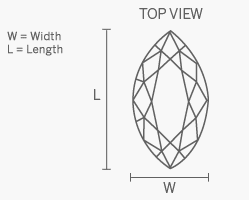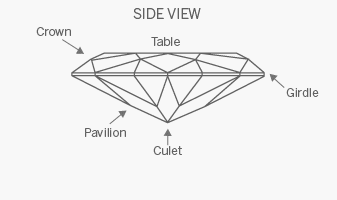Marquise Cut Diamond Shape
The Essential 7C's
Every diamond has its own story, and every lady her own style.
At this point it should be noted that the shape of a diamond can also be referred to as its “cut”, like a round or princess cut. However, this should not be confused with the more commonly used term of diamond cut, which describes how well the diamond has been polished from the raw material (see section on diamond cut).
At Seventy Seven Diamonds we cater to the detailed wishes of every customer and want to ensure that they are well-informed about every diamond shape available. Our selection of beautiful shapes is accompanied by detailed information, images and recommendations on the uniqueness, the history and background, and the ideal ratio of every cut.
Marquise Cut Diamonds
1. The Basics | 2. Features | 3. Expert Advice | 4. History
1. The Basics
Also referred to as: NAVETTE SHAPE

| Unique Features |
Facets |
L/W Ratio |
Origin |
Expert Tip |
| Long "navette" oval shape. |
Usually 56 to 58 |
Ideally 1.85 - 2.10 |
1745 French Royalty. |
Optimises carat weight and elongates finger. |
2. Features



The Marquise Brilliant cut may also be referred to as the "Navette" shape, meaning “little boat,” as the shape of the diamond is said to mirror the hull of a small boat. It is generally comprised of 58 facets, with 33 on the crown and 25 on the pavilion, although the number of pavilion facets may range between 4 and 8. Additionally, Marquise shapes are sometimes cut with a “French tip,” which replaces the large bezel facet at the point with star and upper girdle facets.
French tips are also used in the Heart and Pear shapes. Even though the optimal ratio of the Marquise is 2:1, the shape is more traditionally cut to ratios ranging between 1.85 and 2.10 according to personal preference.
The Marquise can suffer from a so-called “bow-tie effect” when light passing through the diamond casts a shadow across the central facets of the stone. This shadow can be reduced by altering the depth of the pavilion, and adjusting the angles of the table and facets to better diffuse light in the central area. This effect also occurs in the Pear, Oval and Heart shapes.
3. Expert Advice
“The Marquise cut can maximise carat weight, making it appear larger than other stones of the same size and is often set with round or pear-shaped side-stones. As with other elongated shapes, the Marquise can make fingers appear longer and more slender.
It is important that the Marquise is not too shallow so as to avoid light passing through the back of the diamond and diminishing its brilliance and fire.”
4. History & Background
The Marquise cut first appeared in Paris circa 1745 and its fascinating history can be traced back to the height of the French monarchy. King Louis XV commissioned his court jeweller to create a diamond that resembled the smile of his beautiful mistress, the Marchioness Madame de Pompadour. A well-educated and intellectual woman who exerted strong political opinions on the French court, Madame de Pompadour was the official maitresse en titre of King Louis XV between 1745 and 1750.
The shape was then developed and modified throughout the 20th century, evolving into the Marquise Brilliant cut as it is known today, seeing an especial rise in popularity between the 1960s and 1980s. The Marquise cut first appeared in Paris in approximately 1745. The fascinating history of the Marquise cut can be traced back to the height of the French monarchy reign.

Where next?
To view marquise cut diamonds offered by Seventy Seven Diamonds, please click here.
To customise your marquise cut engagement ring, please click here.
If you would like to read more about diamond education, please click here.